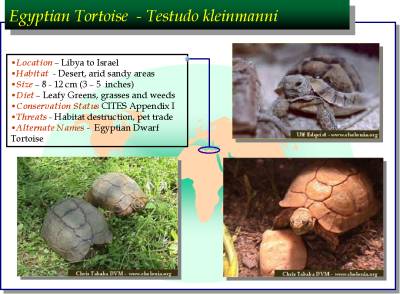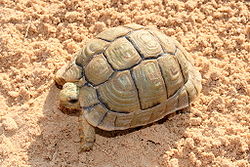Egyptian Tortoise
Kleinmann's Tortois

Protection:
The combination of its small size and beautiful golden color has made Testudo kleinmanni a much sought after addition to tortoise collections. This popularity within the pet trade is second only to habitat loss in terms of impacting the overall wild populations. The Convention on International Trade in Endangered Species of Wild Fauna and Flora (CITES) lists Testudo kleinmanni as an Appendix I species, affording it the highest possible protection. The Egyptian tortoise is also listed as Endangered on the World Conservation Union (IUCN) Red List, which is the second highest designation.
reference:
CITES:
http://www.cites.org/eng/app/Appendices-E.pdf
IUCN:
Violation:
Currently, the main threats endangering this species are intensive commercial collection
for the national and international pet trade, and habitat destruction which has led to its
disappearance from much of its former range in scrub desert and coastal dunes. Agricultural
expansion, cultivation, overgrazing, and urban encroachment have put enormous pressure on
the Egyptian Tortoise’s fragile and dwindling habitat, dramatically reducing available vegetation
for food and cover.
. Sold at Friday Market also called "Souk El Tonsy" besides the district of Al Sayeda Aesha, South of Cairo - - (Souk El Gomaa) - and in many pet shops all over Egypt.
video link youtube: http://www.youtube.com/watch?v=PLFwDzlAfeE
. or in most of the pet shops located all over Egypt
Egyptian Tortoise - Kleinmann's Tortois

Egyptian Tortoise - Kleinmann's Tortois
information contributed by: Wael Shohdi - EWC (Egypt Wildlife Conservation) fb group
source: http://en.wikipedia.org/wiki/Kleinmann%27s_Tortoise
Kleinmann's Tortoise (Testudo kleinmanni), often called Egyptian Tortoise and occasionally Leith's Tortoise. It is a critically endangered neck-hiding tortoise. Once more widespread, its numbers are now dwindling. The species is extinct in Egypt, and global extinction is a looming threat unless more actions are taken to protect this species.
Kleinmann's Tortoise is the smallest tortoise in the northern hemisphere.[verification needed] Female tortoises are larger than the males; males are more slender and have a longer tail.
Their shells have high domes, and range in colour from ivory to pale gold to dark brown or dull yellow. This colouring strongly follows Gloger's Rule as it helps to regulate the impact of sunlight. This allows the paler tortoise to stay in the desert heat for longer. It is also an effective camouflage in the desert. The bottom of the shell is light yellow, often with two dark triangles on each abdominal scute. The tortoise's scutes have dark sidings that fade with age.
The head and limbs are a very pale ivory-yellow to yellowish-brown colour.
Systematics
The proposed subgenus Pseudotestudo is invald, based on immature characters.[1] It has been proposed to unite this species with the Marginated Tortoise in the genus Chersus. These clearly share a common ancestor with the Greek Tortoise. The former two are somewhat more similar to each other than to the Greek Tortoise regarding DNA sequence data.[2] Considering biogeography however, this is either due to (rather unlikely) dispersal across the Mediterranean, or the supposed "clade" is invalid and the similarity due to convergent evolution.
The Negev subpopulation has been separated as a distinct species, Negev Tortoise (Testudo werneri). It does not appear to have distinct or strongly reduced haplotype diversity, consistent with the recent extinction of the Egyptian population (see below) and slow DNA sequence evolution rates in Testudo.[3] It constitutes a locally-adapted form however and is of distinct appearance. Arguably, it can be considered a subspecies and, as gene flow has ceased, the western and eastern populations must now be managed separately for conservation purposes.[4]
Habitat and ecology
Kleinmann's Tortoises live in deserts and semi-arid habitats, usually with compact sand and gravel plains, scattered rocks, shallow, sandy wadis, dry woodlands, shrubby areas, and coastal salt marsh habitats. In captivity, they eat grasses, fruits, and vegetables, but the diet of wild tortoises is unknown.
They are least active when it is very cold or very hot. During the colder months, they are out most during midday. During the warm season, they are active in the morning and evening. The rest of the day is spent under brushes or in rodent burrows.
[edit] Reproduction
Kleinmann's Tortoise becomes sexually mature when about 10-20 years old. In the wild, mating has only been observed in March, but in captivity, they mate in April and August to November. During courtship, the male will ram the female, sometimes chasing after her. Unlike any other Mediterranean tortoise, the T. kleinmanni may make a mating call similar to the call of the Mourning Dove. Eggs are laid in shallow bowls beneath bushes, or in vacant burrows. Each clutch contains 1-5 eggs, which hatch in the summer or early autumn.
[edit] Status and conservation
Once found in Egypt and Libya, their habitat in Egypt has been all but destroyed, and Egyptian Tortoises are now completely extinct there. Two populations can still be found in Libya, but much of the coastline habitat has been destroyed because of human activity. Habitat loss and the illegal pet trade are huge issues facing the species; it is also hunted locally for use in folk medicine.[5] Their population is still on the decline, and the risk of extinction is very real if habitat degradation and illegal trade continue at their present rate.
On the IUCN Redlist, Kleinmann's Tortoise is classified as CR A2abcd+3d. It is estimated that less than three Testudo generations ago, there were 55-56,000 adult Kleinmann's tortoises. Today, there are about 7,500 remaining, and decline due to habitat destruction and unsustainable exploitation appears to be ongoing. While it believed that the former threat is being alleviated, it is feared that illegal pet trade will have reduced to maybe 1,000 adult tortoises in the two or three remaining subpopulations. Given that T. kleinmanni is a slowly-maturing long-lived species with few offspring (see K-strategist), it is well possible that this is less than the minimum viable population, eventually dooming the species to extinction in the wild.[1]
Mixing individuals from the subpopulations for reintroduction purposes should be avoided, as the ecological parameters of habitat differ.[6] DNA fingerprinting of individuals to help maintain heterozygosity in captive and reintroduction populations can be performed during routine stool analyses. In this context it is notable that there may be a haplotype uniquely found in the Egyptian Tortoise.[7]
Captive breeding requires more care than in other Testudo as the species is more delicate and the clutch is very small, but is not highly difficult for experienced Testudo breeders. T. kleinmanni is not generally available for hobbyists and even if legal to keep should be avoided without valid documentation. Smuggling continues to be a problem, but confiscated individuals are used to establish a captive safeguard population.
On May 21, 2007, Rome's main zoo, Bioparco, reported that it has successfully bred the species whose parents were rescued from a smuggler's suitcase in 2005.[8]
السلحفاة المصرية يهددها الانقراض بسبب التجارة غير المشروعة
باتت أصغر سلحفاة في العالم مهددة بالانقراض في مصر امتداد العمران للسواحل والتجارة بها غير المشروعة وتلوث البيئة
السلحفاء المصرية أصغر السلاحف في العالم حجما، لا تعيش سوى في ثلاث دول تقع على ساحل البحر المتوسط "مصر، ليبيا، فلسطين"، وتتركز في مصر بالصحاري الشمالية، خاصة في محمية العميد و محمية الزرنيق، وهي واحدة من خمس أنواع من السلاحف المهددة بالانقراض في العالم.
و يعتقد أنها على وشك الانقراض في مصر، لأسباب متعددة من تجارة غير مشروعة فيها، بسبب الاقبال على التجارة بها حيث يقتنيها البعض كحيوان أليف،هذا بالاضافة إلى تدمير بيئتها الطبيعية نتيجة إستصلاح الأراضى والتنمية العمرانية الساحلية والرعى الجائر، لذلك صنفت السلحفاة المصرية ضمن الفئة الاولى التي تمنع اتفاقية سايتس الدولية اصطيادها وكذلك منع القانون المصري صيدها ونقلها وبيعها.
على الرغم من الاتفاقيات الدولية والقانون المصري يمنع بيع السلحفاة المصرية إلا انها تباع في العديد من المحلات التي تبيع الحيونات الاليفة وكذلك في سوق الجمعة " سوق شعبي شهير بالقاهرة "والذي تباع فيه عشرات السلاحف بشكل يومي للمصريين بسعر لا يتعدى اربعة دولارات، ويصل سعر بيعها للاجانب في حالة تصديرها بين40 ـ100 دولار، لهذا يرى الخبير البيئي سامي الفيلالي يري انه يجب المحافظة على هذا النوع من السلاحف لانها تمثل تراثا طبيعيا نتج عن تطورات فسيولوجية استمرت لملايين السنين إلى أن وصل للجيل الحالي منها،ولهذا فأن السلحفاة المصرية تحتاج الآن وأكثر من أي وقت مضى إلى بذل مزيد من الجهود للحفاظ عليها،لانها في طريقها للانقراض ان لم يعمل الجميع لانقاذهاوتفعيل عقوبات رادعة للاتجار بها حيث تصل غرامة الاتجار بها حاليا إلى 200 جنيه فقط وهذ بالطبع مبلغ هزيل جدا في رايه.
دراسات متعددة حذرت من خطر الانقراض الذي يهدد السلحفاة المصرية كان اخرها دراسة صادرة عن مركز الجمعية المصرية لحماية الحياة البرية تنبأت هذه الدراسة بانقراض هذا الحيوان بشكل نهائي من مصر في غضون عشرين عام إذا لم يتم اتخاذ قرارات للمحافظة على هذا النوع من السلاحف والتي يصفها الدكتور حسن رجب استاذ علم الحيوان بجامعة الزقازيق بأنها كائن وديع، حيث تعد من أصغر السلاحف في العالم،ولا يتجاوز طول الانثى منها 14 سم أما الذكر فهو أصغر حجما وتعيش في بيئات صحراوية أشد جفافا من أي نوع آخر من السلاحف في العالم،وتعتمد في غذائها على النباتات الموسمية الصغيرة التي تظهر بعد سقوط الأمطار،وتضع الانثى عدد من البيض كل سنة يتراوح بين 4 و8 في حفرة صغيرة في الرمال ويفقس هذا البيض بفعل الحرارة بالتربة، وتتعرض السلاحف للعديد من المخاطر من اعدائها الطبيعيين كالغراب وحيوان الورل الصحراوي، بجانب الخطر الاكبر المتمثل في الانسان ولهذا تصل نسبة نفوق هذا الحيوان إلى 90% تقريبا وهي نسبة كبيرة جدا.
ربما تكون هذه الأسباب هي ماجعلت الحكومة المصرية تقوم بالعديد من المشروعات للحفاظ على هذا النوع من الانقراض مثل اقامة مركز لحماية السلاحف المصرية من الانقراض بمحمية الزرنيق حيث يتم اكثارها داخل حظائر مجهزة لذلك ليتم زيادة عددها ثم يتم اطلاقها بعد ذلك في البيئات المناسبة وبدأ هذا المشروع ب50 سلحفاة من الذكور والاناث،ايضا هناك حملات دائما على الاسواق للتفتيش على بيع هذا النوع من السلاحف، ولكن رغم هذه الجهود من جانب الدولة إلا ان الخبير البيئى سامي الفيلالي لا يراها كافية حيث يطالب الدولة بتشديد جهودها لمنع الاتجار في الحيوانات البرية وخاصة هذا النوع من السلاحف وكذلك حماية هذه الكائنات من الصيد وايجاء مشروعات للعمل على اكثار السلاحف في بيئتها الطبيعية وخاصة في مناطق السلوم والمناطق الساحلية على مطروح وسيناء